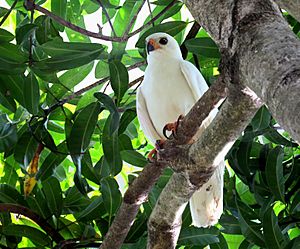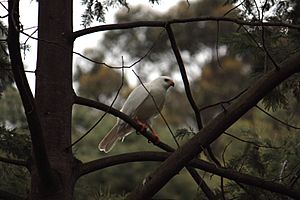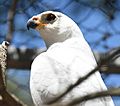Grey goshawk facts for kids
Quick facts for kids Grey goshawk |
|
|---|---|
 |
|
| Conservation status | |
| Scientific classification | |
| Genus: |
Accipiter
|
| Species: |
novaehollandiae
|
The grey goshawk (Accipiter novaehollandiae) is a strong, medium-sized bird of prey. It belongs to the Accipitridae family, which includes many types of hawks and eagles. Some grey goshawks are completely white. These are often called the white goshawk.
Contents
What They Look Like
Grey goshawks come in two main colors, or "morphs." The grey morph has a light grey head and back. Its wingtips are dark, and its chest and tail have grey stripes. Its belly is white.
The white morph is special because it is the only bird of prey in the world that is completely white. Other white birds of prey, like the Gyrfalcon, are not entirely white.
Grey goshawks are the largest Accipiter birds in mainland Australia. They are about 40 to 55 centimeters (16 to 22 inches) long. Their wings can spread from 70 to 110 centimeters (28 to 43 inches) wide.
Female goshawks are much bigger than males. Females weigh about 720 grams (1.6 pounds) on average. Some can even weigh up to 990 grams (2.2 pounds). Males are smaller, weighing about 355 grams (12.5 ounces).
On the Solomon Islands, these birds are much smaller. A female found there weighed only 245 grams (8.6 ounces). Two males averaged 180 grams (6.3 ounces).
Where They Live
The grey goshawk lives along the coasts of northern, eastern, and south-eastern Australia. They are also found in Tasmania. Sometimes, they are seen in Western Australia, but this is rare.
These birds prefer to live in forests and tall woodlands. They also like areas with trees near water.
How They Hunt
Grey goshawks eat different kinds of prey. They often choose whatever food is easiest to catch. Unlike some other Accipiter birds, they often hunt mammals. These can include rabbits, possums, and bats. They also eat small reptiles and insects.
However, their favorite food is usually birds. Female goshawks hunt larger prey than males. Males mostly catch small to medium-sized passerine birds. Females often hunt bigger birds. These can be currawongs, gamebirds, and even herons. Pigeons and parrots are also popular prey for grey goshawks.
Grey goshawks are not as quick in the air as brown goshawks. They are also not as good at twisting and turning to catch prey on the ground. But grey goshawks are stronger. This means they can catch bigger animals.
They often hunt by surprise, sneaking up on their prey. Once they spot their target, they chase it. They catch their prey using their sharp talons.
Life Cycle
Grey and white goshawks can breed together. They usually stay with the same partner for their whole lives. They breed from July to December.
They build their nests in tall trees. The nest is a platform made of sticks and twigs. The middle of the nest is shaped like a bowl and lined with soft green leaves.
The female lays 2 or 3 eggs. She sits on the eggs to keep them warm for about 35 days. This is called incubation.
When the chicks hatch, they stay in the nest for about 35 to 40 days. After this time, they are ready to fledge, which means they can fly.
The female usually takes care of the eggs and feeds the young birds. The male goshawk does most of the hunting to bring food for the family.
Conservation Status
The conservation status of the grey goshawk varies by region.
In the State of Victoria, Australia:
- The grey goshawk is listed as threatened under the Victorian Flora and Fauna Guarantee Act 1988. This means they are at risk.
- On the 2007 list of threatened animals in Victoria, this species was listed as vulnerable. This means they are facing a high risk of extinction in the wild.
In the State of Queensland, Australia:
- This species is listed as least concern. This means their population is stable and not currently at risk.
Gallery
See also
 In Spanish: Azor gris para niños
In Spanish: Azor gris para niños









